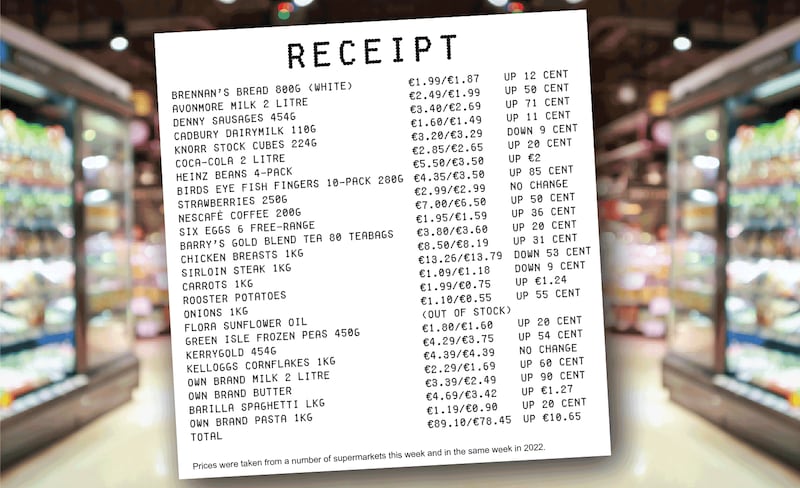Greedflation is a word which is likely to crop up frequently throughout 2023 as concerns mount over businesses potentially bloating their profits by hiking prices while using other inflationary forces as a smoke screen.
Since the start of the cost of living crisis, a largely unquestioned narrative has suggested that soaring prices have been driven by post-pandemic demand, supply shortages and issues with supply chains, energy market disruption, a spike in transport costs and Vladimir Putin’s invasion of Ukraine.
[ Why aren’t our energy prices falling?Opens in new window ]
The narrative has gone unquestioned because all these factors have certainly put upward pressure on prices. There is, however, a growing concern that higher – if not excessive – profits being made by some companies is also playing a part in spiralling prices.
While economists at the European Central Bank (ECB) would never use such a populist portmanteau as greedflation, they have recently started questioning why corporate profits appear so robust at a time of such economic malaise.
READ MORE
And according to both the ECB and Goldman Sachs – hardly a bastion of leftist thinking – higher profits by corporations are driving over half the eurozone’s inflation rate.
While it is unclear just how closely the wider euro zone experience is being mirrored closer to home, it is clear that things have been changing. Fuel prices are now back to where they were in the autumn of 2021, according to the AA, while wholesale energy prices are now around half of what they were at the peak of the crisis last year. Commodity prices on global markets have also started to ease back.
While the general rate of inflation in Ireland has been falling slowly since the start of the year to its current level of 6.3 per cent (based on Friday’s flash estimate from the CSO) from a high of close to 10 per cent, domestic energy prices and prices across Irish supermarkets have yet to follow that downward trajectory.
If anything, many staples are going in the opposite direction and that continues to have an enormous impact on households – with those on the lowest incomes hit disproportionately hard.

In the Autumn of 2021, a litre of full fat own-brand milk in Irish supermarkets cost 75 cent while 454g of own-brand butter was €2.19.
We might not have realised it then but we were living in the good old days, at least when it came to grocery shopping. Today, that litre of milk is priced at €1.15 while the butter costs €3.39.
These price increases of more than 50 per cent look even worse when spread over the course of a year.
[ Cost of the basket in January 2023Opens in new window ]
If a typical Irish household uses eight litres of milk each week, the annual cost at today’s prices is €478.40 compared with €312 in 2021. A year’s supply of butter – if we allow for a household to consume 454g each week – meanwhile, has climbed from €113.88 two years ago to €176.28.
The price hikes, which retailers have blamed on higher input costs – most notably energy and transportation – mean Irish consumers will pay just under €230 over the next year than in the 12 months to the end of December 2021 for these two items alone.
Milk and butter are not the only products that went up in price, however, and up and down Irish supermarket aisles, shoppers are being confronted by increases that would have been unthinkable 18 months ago. A basket of 30 commonly bought products priced this week cost €10 more than the same period last year, which, if spread out over a year amounts to more than €500.
Recent figures from retail analysts Kantar put grocery price inflation at just under 17 per cent with the higher prices costing shoppers over €1,200 a year.
The bad news is things are not likely to get better any time soon. “We’re not going to see any significant price decreases in the foreseeable future,” says retail analyst and TU Dublin lecturer Damian O’Reilly. “The best we can hope for is a decrease in the inflation rate.”
He suggests that by the late summer, inflation might be around 5 per cent but cautions that such a decline “does not mean prices are going to fall. We are going to have price inflation of somewhere between 2 and 4 per cent probably for the next 2-3 years so we are not going to have cheap food any more like we’ve had.”
While prices stay high, voices asking why we have not seen at least some downward pressure in recent months as input costs fell are growing louder.
One of those voices is Labour Party TD and his party’s Enterprise spokesman, Ged Nash. He has called for the Competition and Consumer Protection Commission (CCPC) to investigate what he has described as “potential price gouging” by Irish supermarkets.
He points to falling input prices and asks why prices “remain inexplicably high”.
The CCPC is unlikely to get involved. A spokeswoman told The Irish Times that “there are no price controls for most products in Ireland with traders free to set and change their prices for goods and services.”
She said: “Under Irish competition law, businesses are required to act independently in setting their prices and dominant companies may not use their position to directly or indirectly impose unfair purchase or selling prices or other unfair trading conditions.”
So, in the absence of price collusion across the supermarkets – and there is no suggestion that retailers are working together to keep prices high – the CCPC can’t get involved.
Nash accepts it is not empowered to exert more control when it comes to pricing but expresses concern that people “feel like they’re not being represented” and he says they “need to get angry. Anger is never a policy but the legislative provisions are so minimalistic and when you have a Government that simply decides it’s up to the market to decide where prices are going regardless of what kinds of profits big companies are making then I think the public need to make their views known to the retailers – not staff, they don’t make the decisions – but to company head offices.”
[ ‘I feel misled by Lidl’s massive advertising campaigns using special offers’Opens in new window ]
He notes that it is difficult for shoppers to vote with their feet because “the supermarket next door appears to be charging pretty much the same for the same product”.
The Irish Times asked the State’s five main retailers if and when the price of their own-brand milk and butter might fall in price to reflect lower input costs.
On Friday evening Lidl announced it was cutting the price of its milk by around 5 per cent, a move which takes the price from €1.15 to €1.09.
“There has recently been some reduction in the cost of milk production, and we’re pleased to be in a position to be the first retailer in Ireland to reflect this reduction in our milk prices,” chief executive JP Scally said.
And no sooner had Aldi said it was lowering its prices when Tesco followed suit. On Thursday a spokeswoman had said the pricing of the products are " in line with the competitive market landscape” adding that “we cannot speculate on the future retail price of any product.”
A day later its chief executive Natasha Adams was saying that “with household budgets under increasing pressure we are absolutely committed to helping our customers, by keeping a laser focus on the cost of the weekly shop.”
There was no response from Dunnes Stores.
SuperValu said the “effects of the very significant inflation shock that has been experienced globally that continue to impact the supply chain, as well as ‘input costs in a wide range of areas’ that remain at significantly elevated levels”.
With prices remaining high, the mood of the Irish consumer is dominated by caution, according to the Credit Union Consumer Sentiment index, released on Thursday. It points to a slightly more optimistic outlook in recent weeks but notes that “many consumers still face significant uncertainty and substantial financial strains,” the study suggests.
The results hint at two-track consumer economy with notable increases both in consumers who are comfortable and consumers who are on the precipice of financial disaster as the cost of living crisis continues.
It suggests almost one in five people, or 17 per cent, say they have no way of handling financial emergency, compared to 7 per cent a year ago. While a fall in the price of milk or butter will hardly make a difference to their financial wellbeing, some easing of prices in supermarkets would at least be a start.
And as the phrase goes, every little helps.




















